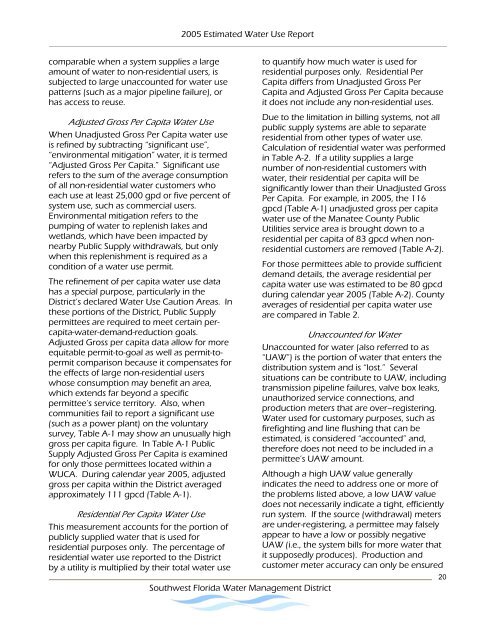Estimated Water Use Report - Southwest Florida Water ...
Estimated Water Use Report - Southwest Florida Water ...
Estimated Water Use Report - Southwest Florida Water ...
You also want an ePaper? Increase the reach of your titles
YUMPU automatically turns print PDFs into web optimized ePapers that Google loves.
2005 <strong>Estimated</strong> <strong>Water</strong> <strong>Use</strong> <strong>Report</strong><br />
comparable when a system supplies a large<br />
amount of water to non-residential users, is<br />
subjected to large unaccounted for water use<br />
patterns (such as a major pipeline failure), or<br />
has access to reuse.<br />
Adjusted Gross Per Capita <strong>Water</strong> <strong>Use</strong><br />
When Unadjusted Gross Per Capita water use<br />
is refined by subtracting “significant use”,<br />
“environmental mitigation” water, it is termed<br />
“Adjusted Gross Per Capita.” Significant use<br />
refers to the sum of the average consumption<br />
of all non-residential water customers who<br />
each use at least 25,000 gpd or five percent of<br />
system use, such as commercial users.<br />
Environmental mitigation refers to the<br />
pumping of water to replenish lakes and<br />
wetlands, which have been impacted by<br />
nearby Public Supply withdrawals, but only<br />
when this replenishment is required as a<br />
condition of a water use permit.<br />
The refinement of per capita water use data<br />
has a special purpose, particularly in the<br />
District’s declared <strong>Water</strong> <strong>Use</strong> Caution Areas. In<br />
these portions of the District, Public Supply<br />
permittees are required to meet certain percapita-water-demand-reduction<br />
goals.<br />
Adjusted Gross per capita data allow for more<br />
equitable permit-to-goal as well as permit-topermit<br />
comparison because it compensates for<br />
the effects of large non-residential users<br />
whose consumption may benefit an area,<br />
which extends far beyond a specific<br />
permittee’s service territory. Also, when<br />
communities fail to report a significant use<br />
(such as a power plant) on the voluntary<br />
survey, Table A-1 may show an unusually high<br />
gross per capita figure. In Table A-1 Public<br />
Supply Adjusted Gross Per Capita is examined<br />
for only those permittees located within a<br />
WUCA. During calendar year 2005, adjusted<br />
gross per capita within the District averaged<br />
approximately 111 gpcd (Table A-1).<br />
Residential Per Capita <strong>Water</strong> <strong>Use</strong><br />
This measurement accounts for the portion of<br />
publicly supplied water that is used for<br />
residential purposes only. The percentage of<br />
residential water use reported to the District<br />
by a utility is multiplied by their total water use<br />
<strong>Southwest</strong> <strong>Florida</strong> <strong>Water</strong> Management District<br />
to quantify how much water is used for<br />
residential purposes only. Residential Per<br />
Capita differs from Unadjusted Gross Per<br />
Capita and Adjusted Gross Per Capita because<br />
it does not include any non-residential uses.<br />
Due to the limitation in billing systems, not all<br />
public supply systems are able to separate<br />
residential from other types of water use.<br />
Calculation of residential water was performed<br />
in Table A-2. If a utility supplies a large<br />
number of non-residential customers with<br />
water, their residential per capita will be<br />
significantly lower than their Unadjusted Gross<br />
Per Capita. For example, in 2005, the 116<br />
gpcd (Table A-1) unadjusted gross per capita<br />
water use of the Manatee County Public<br />
Utilities service area is brought down to a<br />
residential per capita of 83 gpcd when nonresidential<br />
customers are removed (Table A-2).<br />
For those permittees able to provide sufficient<br />
demand details, the average residential per<br />
capita water use was estimated to be 80 gpcd<br />
during calendar year 2005 (Table A-2). County<br />
averages of residential per capita water use<br />
are compared in Table 2.<br />
Unaccounted for <strong>Water</strong><br />
Unaccounted for water (also referred to as<br />
“UAW”) is the portion of water that enters the<br />
distribution system and is “lost.” Several<br />
situations can be contribute to UAW, including<br />
transmission pipeline failures, valve box leaks,<br />
unauthorized service connections, and<br />
production meters that are over–registering.<br />
<strong>Water</strong> used for customary purposes, such as<br />
firefighting and line flushing that can be<br />
estimated, is considered “accounted” and,<br />
therefore does not need to be included in a<br />
permittee’s UAW amount.<br />
Although a high UAW value generally<br />
indicates the need to address one or more of<br />
the problems listed above, a low UAW value<br />
does not necessarily indicate a tight, efficiently<br />
run system. If the source (withdrawal) meters<br />
are under-registering, a permittee may falsely<br />
appear to have a low or possibly negative<br />
UAW (i.e., the system bills for more water that<br />
it supposedly produces). Production and<br />
customer meter accuracy can only be ensured<br />
20
















